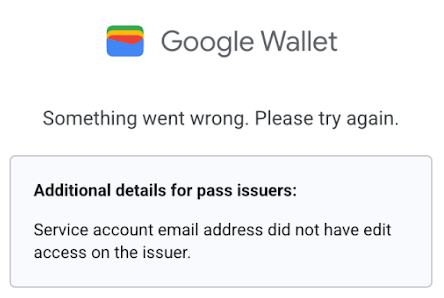การตอบกลับข้อผิดพลาด API
ตารางต่อไปนี้อธิบายรหัสข้อผิดพลาดที่ Google Wallet API อาจส่งคืน สาเหตุที่เป็นไปได้ และวิธีแก้ไข
| ข้อยกเว้น | ข้อความตัวอย่าง | คำแนะนำ |
|---|---|---|
| 400 - BadRequestException | คำขอมีอาร์กิวเมนต์ที่ไม่ถูกต้อง รหัสทรัพยากรไม่ถูกต้อง: {1234567891234567899 - ABCD1234567} | ตรวจสอบโครงสร้างข้อมูลสำหรับประเภท รูปแบบ และความยาว จากนั้นส่งอาร์กิวเมนต์ที่ถูกต้อง |
| 403 - สิทธิ์ปฏิเสธข้อยกเว้น | สิทธิ์ถูกปฏิเสธ | ตรวจสอบว่าอีเมลบัญชีบริการที่ถูกต้องเป็นผู้ใช้ที่ได้รับอนุญาตภายใน Business Pay และ Wallet Console |
| 404 - NotFoundException | ไม่พบ Wallet Object {1234567891234567899.SampleClubCardxf6a8edf-87ca-4022-a813-694cc57e9fd3} | ทำ GET บนรหัสออบเจ็กต์ก่อนลองใช้ก่อนคำขอ PATCH หรือ PUT เพื่อให้มั่นใจว่าคุณมีออบเจ็กต์ที่จะอัปเดตและเป็นเวอร์ชันล่าสุด |
| 404 - IssuerClassNotFoundException | ไม่พบ Wallet Object Class {1234567891234567899.ABCD.1234567} | เมื่อดำเนินการอัปเดต ให้ส่งคำขอ GET ก่อนคำขอ PATCH หรือ PUT เพื่อให้มั่นใจว่าคุณมีคลาสที่จะอ้างอิงว่าเป็นคลาสล่าสุด นอกจากนี้ โปรดตรวจสอบว่ามีการใช้เปย์โหลด (ออบเจ็กต์และคลาส) ที่ถูกต้องในคำขออย่างถูกต้อง |
| 409 - AlreadyExistsException | มี Wallet Object Class {1234567891234567899.ABCD.1234567} อยู่แล้ว | ดำเนินการ GET กับรหัสชั้นเรียนก่อนที่จะสร้างรหัสชั้นเรียนเดียวกัน หากมีทรัพยากรอยู่แล้ว คุณอาจต้องการใช้ PATCH หรือ PUT. |
ข้อความแสดงข้อผิดพลาดบนเว็บ
หากเกิดข้อผิดพลาดเมื่อคุณพยายามบันทึกบัตรโดยใช้ลิงก์ "เพิ่มลงใน Google Wallet" คุณจะเห็นข้อความแสดงข้อผิดพลาดที่ให้ข้อมูลเพื่อช่วยในการแก้ไขข้อบกพร่อง ข้อความเหล่านี้จะแสดงต่อผู้ใช้ที่มีบทบาท "นักพัฒนาซอฟต์แวร์" หรือ "ผู้ดูแลระบบ" สำหรับบัญชีผู้ออกบัตรที่เชื่อมโยงเท่านั้น
ตัวอย่างประเภทข้อความแสดงข้อผิดพลาดที่อาจแสดงมีดังนี้


